Moira Butterfield's Blog, page 48
August 28, 2016
Generating Ideas, by Abie Longstaff
I'm away on holiday so I thought I'd send you my post in visual form.
This is how I get my ideas - I'd love to hear how you get yours.
This is how I get my ideas - I'd love to hear how you get yours.
Published on August 28, 2016 23:00
August 21, 2016
Picture This… Thinking visually in picture book writing. Lucy Rowland
Our guest this week is Lucy Rowland, who is about to have a very exciting picture book 2017. Lucy is a Children's Speech and Language Therapist living and working in London. She started writing picture books around 3 years ago and she’s got her first books coming out with Bloomsbury and Macmillan early next year.
I have always loved language. I have always loved words. My mum tells me that, from a young age, I had an almost encyclopaedic knowledge of nursery rhymes. I grew up listening to my grandparents’ bedtime stories; poetry by A.A.Milne, Dr Seuss, and the rather strange, but wonderful, story of ‘Augustus who would not have any soup’.

At school I studied English, French and German and went on to do a degree in Speech and Language Therapy. So I suppose, in lots of ways, language has always been important to me. But when I started writing picture books, around 3 years ago, it suddenly all made sense. This is what I wanted to do!
I was incredibly lucky to find my wonderful agent, Anne Clark (of Anne Clark Literary Agency) in 2013 while I was travelling in Indonesia. Anne has opened so many doors for me and has given me such valuable advice along the way. I remember one of her first lessons. While sitting in an internet café, on an island with a somewhat intermittent power supply, Anne emailed me a question about a section of my text- ‘Could this be shown in the illustrations instead?’
I realised that I needed to think much more visually. Now, this was hard for me. I am not a visual thinker at all! I don’t tend to have a picture in my head of what my characters look like or how their worlds appear but, in some ways, this makes things all the more exciting!
I’m very new to the picture book world, but so far, one of my favourite parts of the process is that very first time that I get to see the characters. It honestly feels like Christmas Day to me and I get a real feeling of ‘Oh wow! So that’s what he/she looks like!’ My first picture book with the very talented illustrator, Natasha Rimmington, is called ‘Gecko’s Echo’ and will be published by Bloomsbury in January 2017.
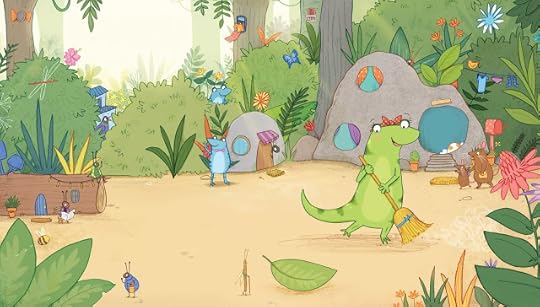

People sometimes ask me, is that how you imagined Gecko? But I’m not sure I really did imagine what Gecko looked like. I’ve watched Natasha develop her over quite a long period of time and I’m amazed when I look at Gecko now and when I look back to Natasha’s initial sketches. Naively, I had no idea just how much work goes into creating these beautiful illustrations. For me, the way Natasha uses light in some of her spreads is just magical and she somehow manages to capture the way Bali felt to me.
I am also lucky enough to have been paired with the wonderful Mark Chambers for two upcoming picture books with Macmillan. The first of these, ‘Pirate Pete and his Smelly Feet’, is out in April 2017. I couldn’t wait to meet Pirate Pete for the first time and Mark did not disappoint!
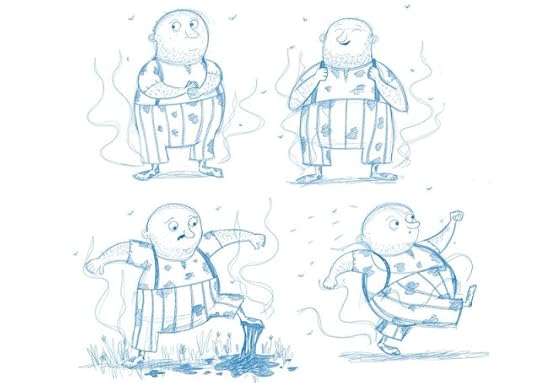
When Mark started working on the book it was really interesting because his ideas helped to change and shape the story even more. I have always loved language but illustrators are visual story tellers and I’m constantly amazed at all the little details they include in their pictures. Not only do these help to drive the story forward but they also add a depth to the characters that my words alone just cannot do.

I’m still working on thinking visually. It’s a lesson that I constantly remind myself of. As I write, I try to think about how the words I choose could support the illustrations, how the language could hint at the action which might be happening in the background. However, in the meantime, I feel incredibly lucky to have been paired with such talented illustrators who are able to show the worlds that I write, and in the most beautiful and powerful of ways.
Lucy’s twitter handle is @lucymayrowland
I have always loved language. I have always loved words. My mum tells me that, from a young age, I had an almost encyclopaedic knowledge of nursery rhymes. I grew up listening to my grandparents’ bedtime stories; poetry by A.A.Milne, Dr Seuss, and the rather strange, but wonderful, story of ‘Augustus who would not have any soup’.

At school I studied English, French and German and went on to do a degree in Speech and Language Therapy. So I suppose, in lots of ways, language has always been important to me. But when I started writing picture books, around 3 years ago, it suddenly all made sense. This is what I wanted to do!
I was incredibly lucky to find my wonderful agent, Anne Clark (of Anne Clark Literary Agency) in 2013 while I was travelling in Indonesia. Anne has opened so many doors for me and has given me such valuable advice along the way. I remember one of her first lessons. While sitting in an internet café, on an island with a somewhat intermittent power supply, Anne emailed me a question about a section of my text- ‘Could this be shown in the illustrations instead?’
I realised that I needed to think much more visually. Now, this was hard for me. I am not a visual thinker at all! I don’t tend to have a picture in my head of what my characters look like or how their worlds appear but, in some ways, this makes things all the more exciting!
I’m very new to the picture book world, but so far, one of my favourite parts of the process is that very first time that I get to see the characters. It honestly feels like Christmas Day to me and I get a real feeling of ‘Oh wow! So that’s what he/she looks like!’ My first picture book with the very talented illustrator, Natasha Rimmington, is called ‘Gecko’s Echo’ and will be published by Bloomsbury in January 2017.


People sometimes ask me, is that how you imagined Gecko? But I’m not sure I really did imagine what Gecko looked like. I’ve watched Natasha develop her over quite a long period of time and I’m amazed when I look at Gecko now and when I look back to Natasha’s initial sketches. Naively, I had no idea just how much work goes into creating these beautiful illustrations. For me, the way Natasha uses light in some of her spreads is just magical and she somehow manages to capture the way Bali felt to me.
I am also lucky enough to have been paired with the wonderful Mark Chambers for two upcoming picture books with Macmillan. The first of these, ‘Pirate Pete and his Smelly Feet’, is out in April 2017. I couldn’t wait to meet Pirate Pete for the first time and Mark did not disappoint!

When Mark started working on the book it was really interesting because his ideas helped to change and shape the story even more. I have always loved language but illustrators are visual story tellers and I’m constantly amazed at all the little details they include in their pictures. Not only do these help to drive the story forward but they also add a depth to the characters that my words alone just cannot do.

I’m still working on thinking visually. It’s a lesson that I constantly remind myself of. As I write, I try to think about how the words I choose could support the illustrations, how the language could hint at the action which might be happening in the background. However, in the meantime, I feel incredibly lucky to have been paired with such talented illustrators who are able to show the worlds that I write, and in the most beautiful and powerful of ways.
Lucy’s twitter handle is @lucymayrowland
Published on August 21, 2016 23:00
August 15, 2016
WHEN DID ANIMALS START BEING SO FUNNY?
by Eoin McLaughlin

There’s nothing the internet loves more than funny animals. And by ‘funny animals’ I mean animals behaving like us humans. What could possibly be funnier? It feels like we’ve all pored over the cat who thinks he’s a pirate, the gopher with the evil look and the sneezing panda since time began. But it’s easy to forget that Youtube is only 11. The internet meme is in its infancy. But picture books are not. Ever since John Newbery published A Little Pretty Pocket-Book, picture books have understood, like no other medium, the comic potential of the right animal doing the wrong thing. All the way from the White Rabbit and Jemima Puddle-Duck to The Tiger Who Came to Tea and Gorilla. More often than not, there’s a funny animal at the centre of our favourite tales. Each generation seems to find their own unique slant on the joke, whether it’s greedy pandas peddling donuts or vicious bears trying to locate their hats. The funny animal is the comic gift that keeps on giving.
But picture books are not. Ever since John Newbery published A Little Pretty Pocket-Book, picture books have understood, like no other medium, the comic potential of the right animal doing the wrong thing. All the way from the White Rabbit and Jemima Puddle-Duck to The Tiger Who Came to Tea and Gorilla. More often than not, there’s a funny animal at the centre of our favourite tales. Each generation seems to find their own unique slant on the joke, whether it’s greedy pandas peddling donuts or vicious bears trying to locate their hats. The funny animal is the comic gift that keeps on giving.
 Four years ago, James Catchpole sold my first picture book to Dial Books. While waiting for it to come out, I have: Married.Moved house three times.Realised that I love mayonnaise.And written my first blog post (you’re reading it, hope it’s going okay!) Amongst all that, I’ve also been reading and writing as much as I can in the hope of learning ‘The Art of Picturebooking’. And whilst, as James will tell you, I’m still very much in Key Stage 0, I have noticed an increasing number of funny animals creeping into my texts. One features an octopus learning to swim, another a bear as a detective. It seems I’m succumbing to the power of the funny animal. Whilst I’m fully embracing this as a good sign that I might be making some progress, it has made me wonder: when did animals start being funny?
Four years ago, James Catchpole sold my first picture book to Dial Books. While waiting for it to come out, I have: Married.Moved house three times.Realised that I love mayonnaise.And written my first blog post (you’re reading it, hope it’s going okay!) Amongst all that, I’ve also been reading and writing as much as I can in the hope of learning ‘The Art of Picturebooking’. And whilst, as James will tell you, I’m still very much in Key Stage 0, I have noticed an increasing number of funny animals creeping into my texts. One features an octopus learning to swim, another a bear as a detective. It seems I’m succumbing to the power of the funny animal. Whilst I’m fully embracing this as a good sign that I might be making some progress, it has made me wonder: when did animals start being funny?

There’s a small scrap of Ancient Egyptian papyrus in the British Museum, dating from the 13th Century BC. It was drawn by a scribe, for sale to ordinary Egyptians outside his local temple. What’s unusual about the papyrus, is that it depicts a cow sitting on a plow, as if she were a farmer rather than a farmyard animal. According to Daniel Antoine, one of the curators at the British Museum, Egyptian texts are full of exactly this kind of imagery. Seeing animals performing human activities was one of the Ancient Egyptians’ all-time favourite gags. It had them LOL’ing and RROTFL.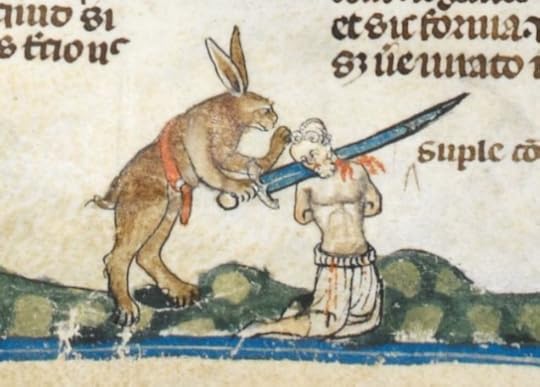 Daniel directed me towards further papyri (yes, apparently that’s the plural) where I found lions playing board games, wolves heading to the shops and cats shepherding ducks. And funny animals didn’t stop there, in medieval marginalia they seem to specialize in dark humour. [Left]
Daniel directed me towards further papyri (yes, apparently that’s the plural) where I found lions playing board games, wolves heading to the shops and cats shepherding ducks. And funny animals didn’t stop there, in medieval marginalia they seem to specialize in dark humour. [Left]
 And by the 18th century, Japanese artist Utagawa Kuniyoshi seems to have already perfected the cat joke. [Left a bit, down a bit]
And by the 18th century, Japanese artist Utagawa Kuniyoshi seems to have already perfected the cat joke. [Left a bit, down a bit]
Whilst the funny animal isn’t regarded the world’s oldest recorded joke (that’s widely credited to be a Sumarian corker about farting) it’s very, very close. One man’s papyrus is another man’s Youtube. Funny animals have been making humans laugh for at least 5,000 years, and presumably much, much longer (before papyrus or papyri).
I guess almost all of us would count our sense of humour as one of the things most personal to ourselves, one of the things that makes us who we are and the primary reason we love the people we do. It’s quite amazing to think that we have this bond in common with our most ancient ancestors. We could have shared a good laugh with them over the picture of a cow and a plow in 5,000 BC or by showing them any number of fantastic, funny animal picture books published in 2016. Isn’t that a nice warm feeling? Let’s bask for a moment in the amazement of inter-generational-super-connection… Ahhhh…
But it does pose a more serious question: “Why, after all that time, are we still picking the very same animals to be funny? For five millennia ducks, dogs, frogs, cows, cats and pigs have been getting things all their own way. Sure, they’ve been a hoot, but isn’t it time to draw a line? Shut the pen? And close the barn door? Wouldn’t it be a good idea to try some new animals for a change? Don’t you think?!” It was at this point that Daniel from the British Museum stopped replying to my emails. He’s obviously part of the funny animal conspiracy. I had no idea how deep it ran. Regardless, it’s time to make a change. All of us gathered here have the unique opportunity to end thousands of years of subjugation. That’s why, right here, right now (drum roll please) I’m launching ‘The Campaign For Getting More Weird Animals, Things Like Marmots And Poison Dart Frogs, Onto Our Papyri, By Which I Mean Children’s Books’, or ‘TCFGMWATLMAPDFFOOPBWIMCB’. Granted, it could do with a catchier name. Perhaps we can think of a new one at the first annual meeting, taking place at The National Hystrix Sanctuary. For the next 5,000 years, bring on the musk ox, the capybara and the skink. To kick things off @eoinmclaughlin will be tweeting a 142 character funny animal story every day this week, featuring a very deserving, obscure animal. Just leave your favourite weird animal in the comments.
Eoin’s first book, This is NOT a Bedtime Story is coming soon from Penguin Random House (Dial Books). More to follow from Walker and Bloomsbury.

There’s nothing the internet loves more than funny animals. And by ‘funny animals’ I mean animals behaving like us humans. What could possibly be funnier? It feels like we’ve all pored over the cat who thinks he’s a pirate, the gopher with the evil look and the sneezing panda since time began. But it’s easy to forget that Youtube is only 11. The internet meme is in its infancy.
 But picture books are not. Ever since John Newbery published A Little Pretty Pocket-Book, picture books have understood, like no other medium, the comic potential of the right animal doing the wrong thing. All the way from the White Rabbit and Jemima Puddle-Duck to The Tiger Who Came to Tea and Gorilla. More often than not, there’s a funny animal at the centre of our favourite tales. Each generation seems to find their own unique slant on the joke, whether it’s greedy pandas peddling donuts or vicious bears trying to locate their hats. The funny animal is the comic gift that keeps on giving.
But picture books are not. Ever since John Newbery published A Little Pretty Pocket-Book, picture books have understood, like no other medium, the comic potential of the right animal doing the wrong thing. All the way from the White Rabbit and Jemima Puddle-Duck to The Tiger Who Came to Tea and Gorilla. More often than not, there’s a funny animal at the centre of our favourite tales. Each generation seems to find their own unique slant on the joke, whether it’s greedy pandas peddling donuts or vicious bears trying to locate their hats. The funny animal is the comic gift that keeps on giving.
 Four years ago, James Catchpole sold my first picture book to Dial Books. While waiting for it to come out, I have: Married.Moved house three times.Realised that I love mayonnaise.And written my first blog post (you’re reading it, hope it’s going okay!) Amongst all that, I’ve also been reading and writing as much as I can in the hope of learning ‘The Art of Picturebooking’. And whilst, as James will tell you, I’m still very much in Key Stage 0, I have noticed an increasing number of funny animals creeping into my texts. One features an octopus learning to swim, another a bear as a detective. It seems I’m succumbing to the power of the funny animal. Whilst I’m fully embracing this as a good sign that I might be making some progress, it has made me wonder: when did animals start being funny?
Four years ago, James Catchpole sold my first picture book to Dial Books. While waiting for it to come out, I have: Married.Moved house three times.Realised that I love mayonnaise.And written my first blog post (you’re reading it, hope it’s going okay!) Amongst all that, I’ve also been reading and writing as much as I can in the hope of learning ‘The Art of Picturebooking’. And whilst, as James will tell you, I’m still very much in Key Stage 0, I have noticed an increasing number of funny animals creeping into my texts. One features an octopus learning to swim, another a bear as a detective. It seems I’m succumbing to the power of the funny animal. Whilst I’m fully embracing this as a good sign that I might be making some progress, it has made me wonder: when did animals start being funny?

There’s a small scrap of Ancient Egyptian papyrus in the British Museum, dating from the 13th Century BC. It was drawn by a scribe, for sale to ordinary Egyptians outside his local temple. What’s unusual about the papyrus, is that it depicts a cow sitting on a plow, as if she were a farmer rather than a farmyard animal. According to Daniel Antoine, one of the curators at the British Museum, Egyptian texts are full of exactly this kind of imagery. Seeing animals performing human activities was one of the Ancient Egyptians’ all-time favourite gags. It had them LOL’ing and RROTFL.
 Daniel directed me towards further papyri (yes, apparently that’s the plural) where I found lions playing board games, wolves heading to the shops and cats shepherding ducks. And funny animals didn’t stop there, in medieval marginalia they seem to specialize in dark humour. [Left]
Daniel directed me towards further papyri (yes, apparently that’s the plural) where I found lions playing board games, wolves heading to the shops and cats shepherding ducks. And funny animals didn’t stop there, in medieval marginalia they seem to specialize in dark humour. [Left] And by the 18th century, Japanese artist Utagawa Kuniyoshi seems to have already perfected the cat joke. [Left a bit, down a bit]
And by the 18th century, Japanese artist Utagawa Kuniyoshi seems to have already perfected the cat joke. [Left a bit, down a bit]
Whilst the funny animal isn’t regarded the world’s oldest recorded joke (that’s widely credited to be a Sumarian corker about farting) it’s very, very close. One man’s papyrus is another man’s Youtube. Funny animals have been making humans laugh for at least 5,000 years, and presumably much, much longer (before papyrus or papyri).
I guess almost all of us would count our sense of humour as one of the things most personal to ourselves, one of the things that makes us who we are and the primary reason we love the people we do. It’s quite amazing to think that we have this bond in common with our most ancient ancestors. We could have shared a good laugh with them over the picture of a cow and a plow in 5,000 BC or by showing them any number of fantastic, funny animal picture books published in 2016. Isn’t that a nice warm feeling? Let’s bask for a moment in the amazement of inter-generational-super-connection… Ahhhh…

But it does pose a more serious question: “Why, after all that time, are we still picking the very same animals to be funny? For five millennia ducks, dogs, frogs, cows, cats and pigs have been getting things all their own way. Sure, they’ve been a hoot, but isn’t it time to draw a line? Shut the pen? And close the barn door? Wouldn’t it be a good idea to try some new animals for a change? Don’t you think?!” It was at this point that Daniel from the British Museum stopped replying to my emails. He’s obviously part of the funny animal conspiracy. I had no idea how deep it ran. Regardless, it’s time to make a change. All of us gathered here have the unique opportunity to end thousands of years of subjugation. That’s why, right here, right now (drum roll please) I’m launching ‘The Campaign For Getting More Weird Animals, Things Like Marmots And Poison Dart Frogs, Onto Our Papyri, By Which I Mean Children’s Books’, or ‘TCFGMWATLMAPDFFOOPBWIMCB’. Granted, it could do with a catchier name. Perhaps we can think of a new one at the first annual meeting, taking place at The National Hystrix Sanctuary. For the next 5,000 years, bring on the musk ox, the capybara and the skink. To kick things off @eoinmclaughlin will be tweeting a 142 character funny animal story every day this week, featuring a very deserving, obscure animal. Just leave your favourite weird animal in the comments.
Eoin’s first book, This is NOT a Bedtime Story is coming soon from Penguin Random House (Dial Books). More to follow from Walker and Bloomsbury.
Published on August 15, 2016 00:00
August 7, 2016
Why Are Picture Book Sooooo Short? Musings on Word Count
Every agent and publisher seems to be in agreement – do not send us anything but short picture book texts, preferably under 600 words.
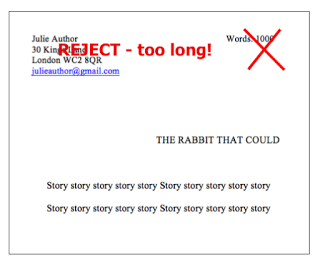
 “Parents don’t want to read long bedtime stories," they argue. "They are frazzled at the end of long, busy days.”
“Parents don’t want to read long bedtime stories," they argue. "They are frazzled at the end of long, busy days.” “Children have short(er) attention spans – from babyhood they are already learning to get stuff quickly.”
 “Translating long texts is more expensive, so long texts don’t sell abroad.” (Without co-editions many picture books are financially inviable).
“Translating long texts is more expensive, so long texts don’t sell abroad.” (Without co-editions many picture books are financially inviable). 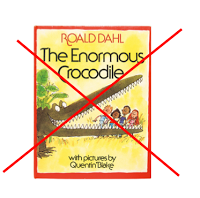
“Long picture books don’t sell.”
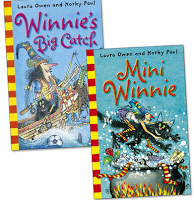
“Older children don’t want to read picture books – they
want to read ‘proper’ chapter books and early readers just as soon as they are able!”
Hmmm, is this all really true? Are we (literally) selling our children short? By publishing only shorter picture books are publishers making them the norm and therefore creating a self-fulfilling prophecy?
Let me preface what comes next by saying that I love picture books and believe there is a place for lots of different kinds of books. After all, as a child and an adult, we read different books at different times of the day and different times of our lives. This is the wonderful thing about different sorts of stories.
Consider for a moment what a longer picture book can offer:
A deliciously more involved story for slightly older children (and adults who are still children) who are able to sit still longer, savour more intriguing vocabulary, enjoy rhythmical language and delight in more sophisticated visual literacy.
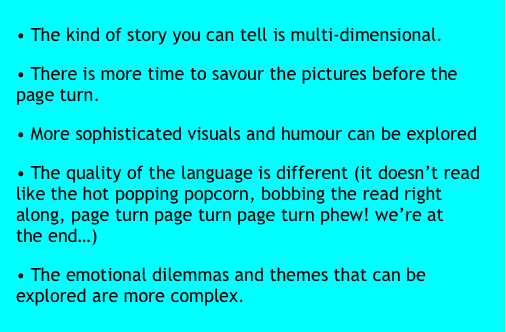
I decided to do a little bit of research. If you look, there are some very successful
longer picture books such as:

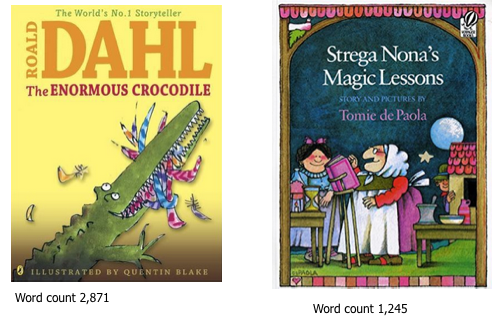


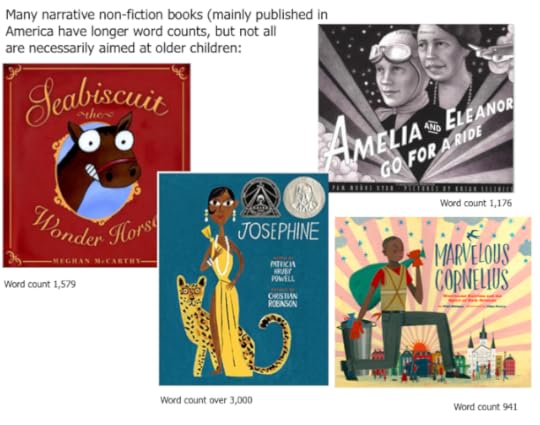
Notice how the writing in these books is not just long for the sake of long. No, they have been well-written, well-edited and are tightly structured. The writing is artful writing, not waffle. But it may just be about 1000 words long. It doesn’t feel like it takes an age to read, though. As a reader, you savour the experience, the journey into a different world, the emotional connection with the characters and their situations. Arguably, the types of stories they can tell resonate a little deeper perhaps?
By contrast, reading a super-quick, reads-almost-like-a-joke quirky contemporary picture book feels just like that – almost breahtless sometimes, a super-quick ‘done it’ moment in time. Of course, lots of these books are fun and make important contributions to the wealth of children's literature available. But I wonder: shouldn't picture books also satisfy older readers who are in a different place on their literary journey?
Also, note that many of these examples are classics. They still sell. They can’t be dinosaurs yet. Short attention-spanned children and over-tired adults must be reading them still!
Some editors are clearly acquiring these longer picture books that grow with young readers.
Who, I wonder, will be bold enough to break the cycle and recognize that there is a place for these sorts of picture books (and not just non-fiction ones), that we oughtn't to be selling our young readers short, that longer picture books are needed too?
Natascha Biebow
Author, Editor and Mentor
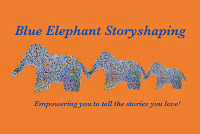 Blue Elephant Storyshaping is an editing, coaching and mentoring service aimed at empowering writers and illustrators to fine-tune their work pre-submission. Check out my small-group coaching Cook Up a Picture Book courses!
Blue Elephant Storyshaping is an editing, coaching and mentoring service aimed at empowering writers and illustrators to fine-tune their work pre-submission. Check out my small-group coaching Cook Up a Picture Book courses!Natascha is also the author of Elephants Never Forget and Is This My Nose?, editor of numerous award-winning children’s books, and Regional Advisor (Chair) of SCBWI British Isles.
Published on August 07, 2016 20:00
Why Are Picture Book Sooooo Short?
Every agent and publisher seems to be in agreement – do not send us anything but short picture book texts, preferably under 600 words.

 “Parents don’t want to read long bedtime stories," they argue. "They are frazzled at the end of long, busy days.”
“Parents don’t want to read long bedtime stories," they argue. "They are frazzled at the end of long, busy days.” “Children have short(er) attention spans – from babyhood they are already learning to get stuff quickly.”
 “Translating long texts is more expensive, so long texts don’t sell abroad.” (Without co-editions many picture books are financially inviable).
“Translating long texts is more expensive, so long texts don’t sell abroad.” (Without co-editions many picture books are financially inviable). 
“Long picture books don’t sell.”

“Older children don’t want to read picture books – they
want to read ‘proper’ chapter books and early readers just as soon as they are able!”
Hmmm, is this all really true? Are we (literally) selling our children short? By publishing only shorter picture books are publishers making them the norm and therefore creating a self-fulfilling prophecy?
Let me preface what comes next by saying that I love picture books and believe there is a place for lots of different kinds of books. After all, as a child and an adult, we read different books at different times of the day and different times of our lives. This is the wonderful thing about different sorts of stories.
Consider for a moment what a longer picture book can offer:
A deliciously more involved story for slightly older children (and adults who are still children) who are able to sit still longer, savour more intriguing vocabulary, enjoy rhythmical language and delight in more sophisticated visual literacy.

I decided to do a little bit of research. If you look, there are some very successful
longer picture books such as:





Notice how the writing in these books is not just long for the sake of long. No, they have been well-written, well-edited and are tightly structured. The writing is artful writing, not waffle. But it may just be about 1000 words long. It doesn’t feel like it takes an age to read, though. As a reader, you savour the experience, the journey into a different world, the emotional connection with the characters and their situations. Arguably, the types of stories they can tell resonate a little deeper perhaps?
By contrast, reading a super-quick, reads-almost-like-a-joke quirky contemporary picture book feels just like that – almost breahtless sometimes, a super-quick ‘done it’ moment in time. Of course, lots of these books are fun and make important contributions to the wealth of children's literature available. But I wonder: shouldn't picture books also satisfy older readers who are in a different place on their literary journey?
Also, note that many of these examples are classics. They still sell. They can’t be dinosaurs yet. Short attention-spanned children and over-tired adults must be reading them still!
Some editors are clearly acquiring these longer picture books that grow with young readers.
Who, I wonder, will be bold enough to break the cycle and recognize that there is a place for these sorts of picture books (and not just non-fiction ones), that we oughtn't to be selling our young readers short, that longer picture books are needed too?
Natascha Biebow
Author, Editor and Mentor
 Blue Elephant Storyshaping is an editing, coaching and mentoring service aimed at empowering writers and illustrators to fine-tune their work pre-submission. Check out my small-group coaching Cook Up a Picture Book courses!
Blue Elephant Storyshaping is an editing, coaching and mentoring service aimed at empowering writers and illustrators to fine-tune their work pre-submission. Check out my small-group coaching Cook Up a Picture Book courses!Natascha is also the author of Elephants Never Forget and Is This My Nose?, editor of numerous award-winning children’s books, and Regional Advisor (Chair) of SCBWI British Isles.
Published on August 07, 2016 20:00
July 31, 2016
Beautiful Books, by Pippa Goodhart
There have always been beautiful books, right back to the days of hand written illuminated manuscripts. Illustration - picture books - are perhaps the most obvious source of beauty in books. But the binding of a book can also be a lovely thing to see and touch and smell. It's a treat to see gilded page edges, silken book mark ribbons, imaginative endpapers and handsome bindings being used to make current children's books particularly beautiful.
You may wonder why there are no pictures in this blog. That's because I'm not going to talk about modern examples of beautifully produced picture books. I'd love you to tell of examples you admire in the comments. But I want to share with you a treasure I have just discovered that takes me right back to what first tuned me in to how beautiful books could be.
In our village was a big house where a man called Sandy Cockerell and his wife Mary. He was a bookbinder. My brother Dick was keen on printing. Dick had his own little Adana printing press with which he printed things such as book plates for me to label my books with. Because of his interest in printing and books, he was invited to visit the Cockerells, and, lucky me, I was invited to go with him. He was probably about eleven and I was about nine.
We were left at the Cockerell's by our Mum, and we had the most magical time, being shown how to make marbled paper by the best paper marbler in the world. I was mightily impressed with his eyebrows, and with the fresh bread and honey that his wife gave us, but, best of all, we were allowed to try marbling for ourselves. For months afterwards I tried to get the same effect with poster paints on water, using combs and sticks to drag patterns, and it did sort of work. I also stitched crude bookbinding, making book covers with roughly embroidered pictures and bits of card board and tape and leather and all sorts. I thought I'd like to be a bookbinder one day ... but ended up making up the stories and ordering the words that go inside them instead.
Anyway, here is the treasure that I found on Youtube ...
Art of the Marbler Filmed in 1970, probably just a couple of years after my visit, here is Cockerell paper being made. You need to make a cup of something, sit back, and enjoy the slow pace of the film that eventually shows you a sort of magical book beauty in action.
Published on July 31, 2016 16:30
July 24, 2016
What parents think of picture books - A small survey. Moira Butterfield
I decided to ask some current picture book users a few questions, so I set up a small survey using Survey Monkey, put it on Facebook and asked friends with young children their views. Now I don’t have a massive number of followers so this was a teeny-tiny survey of acquaintances and not remotely a scientific cross-section of the population. But the answers were interesting nevertheless, and made me think. I hope you find them thought-provoking, too.
1. “What price do you think is about right for a paperback picture book?”
The answer was overwhelmingly £3 to £4.50. Picture books were seen by everybody as low-cost items, which could be seen as depressing from the creator’s end. But given that all the respondents said they read a picture book every single day to their child, this makes picture books incredible value for money! The best buy a parent can make, surely?
2. “What is your child’s current favourite picture book?”
Various Julia Donaldson titles won hands-down, by a mile. These are adults answering the question, of course. The answer could be their favourite book because they find it easy to read the clear rhyme and clear story of a Julia Donaldson book (see question 6). Children will work out that they are going to get a happy one-to-one sharing experience if they ask for a book their parent likes.
This is one to think about. Should would-be picture book authors actually be copying this format for commercial success? Rhymes, super-clear rhythm that you can’t go wrong reading out + a very clear story? Is any kind of experimentation that deviates from that a marketing mistake? Discussion welcomed!
3. “Where do you buy picture books?”
The answer was split pretty much 50/50 between ‘online and ‘supermarkets’, with ‘bookshop’ a distant third. Supermarkets heavily feature well-known books and online sellers direct people along the same lines, so that’d go some way to explaining the overwhelming dominance of Julia Donaldson in the UK, I think. To be honest, it’s hard to see how a new author or illustrator could make a dent if those stats hold in the wider community (I can't say that they do, of course). is that being too defeatist?
4. “Roughly how often do you read a picture book with your child?”
The answer was mainly “every day” with a couple of complete book heroes who said “Four stories a night” and Multiple times a day”. Everybody salute these incredible parents! About half the respondents stipulated that they read every night before bedtime. Something to think about there when it comes to books with overtly scary pictures and texts. They could be limiting their market.
5. “What would make you buy a picture book?”
I gave multiple answers to choose from here. The overwhelming winner was “You like the look of the art” followed by “It’s a book you remember from your childhood” and then – a little way back - “It’s by an author you like” - followed by “It features a TV or film character your child knows.”
So there is hope for authors but it’s the look that counts in the main, along with buying the tried and tested, with this small group.
Pleasingly not one respondent chose the answer “Because it was written by a celebrity”.
Those that commented further on the style of art they liked said they preferred lots to spot in the pictures.
6. “Is there anything about picture books that irritates you?”
Two-thirds of the respondents didn’t add an answer, which shows, I guess, that they were happy about the picture books they read and gave them a big thumbs-up.
The answers I did get were very interesting.
“Scary pictures” was one. Now that feeds into my own view that children’s picture book award short lists can tend to favour unbelievably scary-looking visuals, without thought for the end users. I'm pleased that this year's Kate Greenaway shortlist looks much better than last year's in that respect.
“Books that start to rhyme and don’t continue to rhyme” was another comment, along with “When it doesn’t flow.” Yup, bad rhyme and bad rhythm is the pits! But there’s another point here for authors, I think. It’s hard for people to read rhythm that isn’t absolutely clear. So while you may think your text rhythm flows (because you know how it should be read) will a reader do so? Are there places where they could trip up? Is the rhythm cast-iron enough for them to not go wrong? Testing the text out on friends, asking them to read it out loud with no guidance at all from you, could help here.
Rhyme is important, according to the person who wrote “Rhyming books are so much easier to read after a long day with the kids.” Interesting point! When you’re tired and haven’t much acting energy left, it’s easy rhymes that you want. Julia Donaldson-style - or Dr. Seuss maybe.
“Lack of actual story” was another comment. I can see that, too. Given that most respondents said they read a book at night, and I’m guessing (as above) they’re weary, they could be wanting something straightforward that doesn't require them to do lots of explaining, perhaps.
I hope you’re not depressed by the above and it gives you food for thought. It’s just the comments of a tiny selection of parents, but they're being helpfully honest about their own experience. They’re not remotely connected to the publishing industry. They're the end-users of picture books and I think their views matter. Getting work accepted by publishers relies on it being market-friendly, so it is worth thinking about the experience someone would have reading your story – perhaps in a slightly weary voice by the bedside!
All reactions gratefully received below.
Moira Butterfield@moiraworldwww.moirabutterfield.com
Latest picture book work:
“Everybody Feels…” series by QED
Published on July 24, 2016 21:00
July 17, 2016
What do you want to be when you grow up? by Malachy Doyle
Just because I spend my time writing sweet and lovely picture books doesn’t mean I’m not the ambitious type.
When I was 10 I wanted to:
- Score the winning goal for Tottenham Hotspur in the FA Cup Final.
- Win Wimbledon, and run fast enough to win an Olympic Gold Medal for Ireland. - Be on Top of the Pops and have a number one hit single.

When I was 20 I wanted to:
- Change the world.
- Avoid work.
- Make babies.
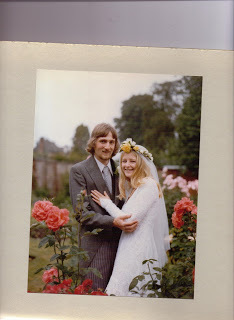
When I was 30 I wanted to:
- Get out of advertising.
- Get out of town.
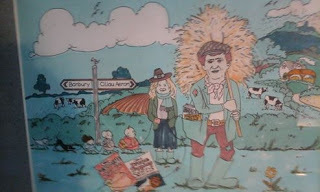
When I was 40 I wanted to:
- Run away and write.

When I was 50 I wanted to:
- Make the perfect picture book.
- Become a smiley grandad.- Go home to Ireland.
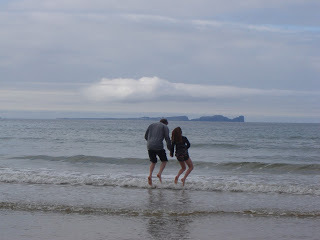
Now I’m 60 and a bit I want to:
- Run 5k in under 25 minutes.
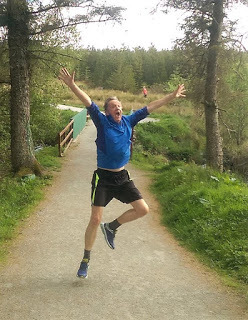
- Climb Everest.

- Spend time with my lovely grandchildren
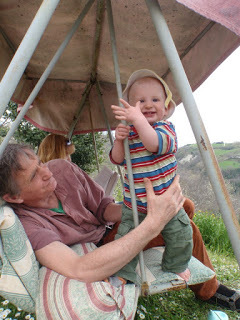
and Make the perfect picture book.
Some things change. Some things stay the same.
Malachy's latest book is Sea Stories (OUP Treetops). There are others on the way from Walker Books, from Firefly Press, from Parragon, Pearson and hopefully, maybe, more.
Published on July 17, 2016 12:38
July 10, 2016
From Syria to the UK, diversity and children's picture books by Nadine Kaadan (Guest Blogger)
Here at the Picture Book Den we're delighted that this week our guest blogger is Syrian author and illustrator, Nadine Kaadan. From a previous blog post, some of you may remember her Arab picture book on coping with the conflict in Syria. Now Nadine discusses her path into publishing, the influence of Damascus, and diversity in picture books.
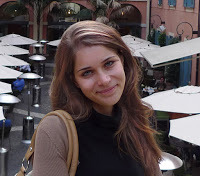 Nadine KaadanI started writing and illustrating children’s books when I was 10 years old. I photocopied my stories, coloured them, and (tried) to sell them to whoever was interested (almost always at a 100% loss). I pretty much gave them away and just loved it. It was simply my passion, and after studying fine arts at the University of Damascus with a focus on children’s illustrations, here I am 20 years later still doing the same, as my full-time job.
Nadine KaadanI started writing and illustrating children’s books when I was 10 years old. I photocopied my stories, coloured them, and (tried) to sell them to whoever was interested (almost always at a 100% loss). I pretty much gave them away and just loved it. It was simply my passion, and after studying fine arts at the University of Damascus with a focus on children’s illustrations, here I am 20 years later still doing the same, as my full-time job.
My first book was published by a Jordanian publisher at the age of 21 years, and I then worked with various Arab publishers in Syria, UAE, Lebanon, Jordan, and Saudi Arabia. In 2011, because of the conflict at home, I travelled to London and completed a Masters in Illustration at Kingston University, and then an MA in Art and Politics at Goldsmiths College.
Looking back at the magazine I created at the age of 10, I realise that almost all of the characters in my stories had western names, although there weren’t foreign children around me. I think this was simply due to a lack of local Syrian children’s books at the time, and the fact that I was surrounded by French and English children’s stories. Growing up, I made it a point to develop more of an indigenous style inspired by local aesthetics and by my lovely city, Damascus.
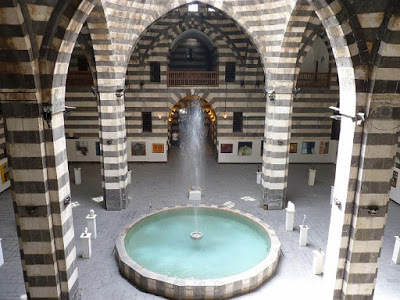
I always found myself fascinated by the rosy side of the oldest capital in the world, especially the architecture and feel of the old city. By its courtyard fountains and their peaceful trickle – cool and fresh in the hot Damascus summer. By the beautiful contrast that the narrow alleyways make when walking between shadows and sun. And by the sweet scent of jasmine and rose, spreading everywhere in the summer nights. I found myself discovering and imagining thousands of tales hidden in every corner of the ancient city.
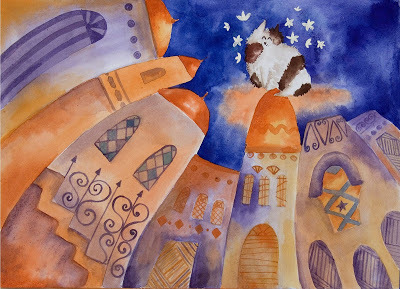 Illustration by Nadine KaadanThe unique architecture of Damascus always features in my illustrations. An example of this is my book
Answer me, Leila!
, a story that starts like a Rapunzel fairy tale, but ends with a twist. When Prince Sami arrives at the high orange castle and calls for Leila to dangle her hair down from the window, she doesn’t answer him. He tries again and again, until he realizes that Leila can’t hear him because she’s hard of hearing and speaks a different language, called sign language. The book is dedicated to children with hearing difficulties.
Illustration by Nadine KaadanThe unique architecture of Damascus always features in my illustrations. An example of this is my book
Answer me, Leila!
, a story that starts like a Rapunzel fairy tale, but ends with a twist. When Prince Sami arrives at the high orange castle and calls for Leila to dangle her hair down from the window, she doesn’t answer him. He tries again and again, until he realizes that Leila can’t hear him because she’s hard of hearing and speaks a different language, called sign language. The book is dedicated to children with hearing difficulties.
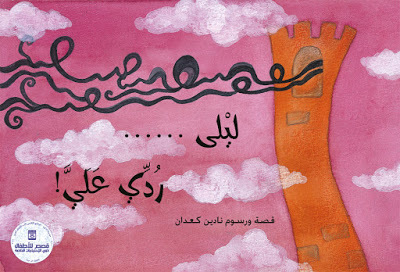 From
Answer me, Leila!
by Nadine Kaadan
From
Answer me, Leila!
by Nadine Kaadan
(Box of Tales Publishing House, 2011)
When conceiving the story, naturally I drew a local-looking princess, with long black hair, in a castle inspired by colourful Damascene tiles, and with roses and plants as reoccurring decorative motives. I portrayed Leila the deaf princess as an empowered female character (not a victim) who finds a creative solution to Sami’s struggle to reach her, by writing out words with her long hair to grab his attention and communicate with him in fun Arabic calligraphy. The motto of the tale is that there are many different ways to communicate… so let’s find them together!
 From
Answer me, Leila!
by Nadine Kaadan
From
Answer me, Leila!
by Nadine Kaadan
(Box of Tales Publishing House, 2011)Living in the UK for the past four years has been a wonderful learning experience, but I was surprised by the lack of topical diversity in the children’s book market. I didn’t feel that it was sufficiently reflected in a country that upholds and celebrates diversity and multiculturalism so well. This year I was part of a panel discussion at the London Book Fair under the title What works in translating children’s literature, and I argued that even when there is an attempt by UK publishers to publish more inclusive and diverse books, they still fall into the danger of the single story. For example, looking at UK children’s books that feature Arab or Middle Eastern culture, I feel that there is an exaggerated focus on ‘cultural differences’ (in the name of cultural richness). Too many of these books strike me as quite orientalist, and seem to depict overly stereotypical clichés about Arab culture, such as the typical camels in the desert and fasting in Ramadan. Although these elements are very much a part of our culture, and the stories are absolutely worthy of publication, the problem is that they only present one aspect of who we are.
I truly believe that stories should be chosen to be published or translated in the UK because they are strong, regardless of whether they are about themes of cultural diversity, or not. For example I would like to see books in the UK from the Arab world that address stories of single working mothers, or of talented artists, or of teenagers going through identity struggles. Stories such as these would better represent the diverse and more realistic representation of my region, and would indeed show more of what we have in common, and not just the differences.
 The Jasmine Sneeze
by Nadine Kaadan
The Jasmine Sneeze
by Nadine Kaadan
(Lantana Publishing, 2015)
I was privileged to be able to publish a story here in the UK, The Jasmine Sneeze , by Lantana Publishing, and my first one in English. The Jasmine Sneeze is about Haroun, the cat, who likes nothing better than to spend his days sleeping in the sunlit courtyards of Damascus. But one thing always ruins his sleep: jasmine! Haroun can’t stand the sweet-scented flowers. Their pollen sends him into fits of sneezes! Haroun hatches a plan to fix the problem. But little does he know that in doing so he deeply angers the Jasmine Spirit who plans her revenge in her own crafty way.
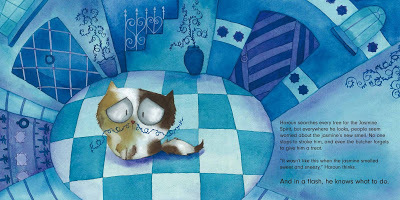 From
The Jasmine Sneeze
by Nadine KaadanI chose jasmine for my story simply because Damascus is known as the City of Jasmine – the flowers are a much-loved feature of the city’s courtyards and alleyways and give the city its distinct odor, especially on cool summer nights. As part of their morning ritual, Damascenes will wake and collect fallen jasmine flowers and place the petals on their water fountains so that the smell can be carried all over the house.
From
The Jasmine Sneeze
by Nadine KaadanI chose jasmine for my story simply because Damascus is known as the City of Jasmine – the flowers are a much-loved feature of the city’s courtyards and alleyways and give the city its distinct odor, especially on cool summer nights. As part of their morning ritual, Damascenes will wake and collect fallen jasmine flowers and place the petals on their water fountains so that the smell can be carried all over the house.

Many people in my city like to believe that the jasmine plant reacts to and reflects what is happening in their homes and lives, in good times and bad. They often associate the drooping jasmine stems with grieving and loss, and when a member of their family passes, they believe that the jasmine mourns after him or her. The idea for this story came to me when I thought back on how often my mother used to tell me about her grandmother’s jasmine tree. My mother speaks of how, a day before her grandmother passed away, the jasmine in their courtyard suddenly became harsh and wild, as though in warning that something sad was about to happen. When my mother’s grandmother passed, the jasmine died the day after. This story stayed in mind and when I was young I always wondered: who lives inside the jasmine tree?
 Who lives in the jasmine tree?
Who lives in the jasmine tree?
From The Jasmine Sneeze by Nadine Kaadan (Lantana Publishing, 2015)
I hope my story is a small beginning to more Syrian stories in the UK, especially during a time of devastating war, prejudice and misrepresentation of the Syrian people. Diversity and variety in picture books benefits everyone.
Nadine Kaadan
For more on Nadine and The Jasmine Sneeze (UK) and her 15 Arab picture books, please visit www.nadinekaadan.com
 Nadine KaadanI started writing and illustrating children’s books when I was 10 years old. I photocopied my stories, coloured them, and (tried) to sell them to whoever was interested (almost always at a 100% loss). I pretty much gave them away and just loved it. It was simply my passion, and after studying fine arts at the University of Damascus with a focus on children’s illustrations, here I am 20 years later still doing the same, as my full-time job.
Nadine KaadanI started writing and illustrating children’s books when I was 10 years old. I photocopied my stories, coloured them, and (tried) to sell them to whoever was interested (almost always at a 100% loss). I pretty much gave them away and just loved it. It was simply my passion, and after studying fine arts at the University of Damascus with a focus on children’s illustrations, here I am 20 years later still doing the same, as my full-time job. My first book was published by a Jordanian publisher at the age of 21 years, and I then worked with various Arab publishers in Syria, UAE, Lebanon, Jordan, and Saudi Arabia. In 2011, because of the conflict at home, I travelled to London and completed a Masters in Illustration at Kingston University, and then an MA in Art and Politics at Goldsmiths College.
Looking back at the magazine I created at the age of 10, I realise that almost all of the characters in my stories had western names, although there weren’t foreign children around me. I think this was simply due to a lack of local Syrian children’s books at the time, and the fact that I was surrounded by French and English children’s stories. Growing up, I made it a point to develop more of an indigenous style inspired by local aesthetics and by my lovely city, Damascus.

I always found myself fascinated by the rosy side of the oldest capital in the world, especially the architecture and feel of the old city. By its courtyard fountains and their peaceful trickle – cool and fresh in the hot Damascus summer. By the beautiful contrast that the narrow alleyways make when walking between shadows and sun. And by the sweet scent of jasmine and rose, spreading everywhere in the summer nights. I found myself discovering and imagining thousands of tales hidden in every corner of the ancient city.
 Illustration by Nadine KaadanThe unique architecture of Damascus always features in my illustrations. An example of this is my book
Answer me, Leila!
, a story that starts like a Rapunzel fairy tale, but ends with a twist. When Prince Sami arrives at the high orange castle and calls for Leila to dangle her hair down from the window, she doesn’t answer him. He tries again and again, until he realizes that Leila can’t hear him because she’s hard of hearing and speaks a different language, called sign language. The book is dedicated to children with hearing difficulties.
Illustration by Nadine KaadanThe unique architecture of Damascus always features in my illustrations. An example of this is my book
Answer me, Leila!
, a story that starts like a Rapunzel fairy tale, but ends with a twist. When Prince Sami arrives at the high orange castle and calls for Leila to dangle her hair down from the window, she doesn’t answer him. He tries again and again, until he realizes that Leila can’t hear him because she’s hard of hearing and speaks a different language, called sign language. The book is dedicated to children with hearing difficulties.  From
Answer me, Leila!
by Nadine Kaadan
From
Answer me, Leila!
by Nadine Kaadan(Box of Tales Publishing House, 2011)
When conceiving the story, naturally I drew a local-looking princess, with long black hair, in a castle inspired by colourful Damascene tiles, and with roses and plants as reoccurring decorative motives. I portrayed Leila the deaf princess as an empowered female character (not a victim) who finds a creative solution to Sami’s struggle to reach her, by writing out words with her long hair to grab his attention and communicate with him in fun Arabic calligraphy. The motto of the tale is that there are many different ways to communicate… so let’s find them together!
 From
Answer me, Leila!
by Nadine Kaadan
From
Answer me, Leila!
by Nadine Kaadan(Box of Tales Publishing House, 2011)Living in the UK for the past four years has been a wonderful learning experience, but I was surprised by the lack of topical diversity in the children’s book market. I didn’t feel that it was sufficiently reflected in a country that upholds and celebrates diversity and multiculturalism so well. This year I was part of a panel discussion at the London Book Fair under the title What works in translating children’s literature, and I argued that even when there is an attempt by UK publishers to publish more inclusive and diverse books, they still fall into the danger of the single story. For example, looking at UK children’s books that feature Arab or Middle Eastern culture, I feel that there is an exaggerated focus on ‘cultural differences’ (in the name of cultural richness). Too many of these books strike me as quite orientalist, and seem to depict overly stereotypical clichés about Arab culture, such as the typical camels in the desert and fasting in Ramadan. Although these elements are very much a part of our culture, and the stories are absolutely worthy of publication, the problem is that they only present one aspect of who we are.
I truly believe that stories should be chosen to be published or translated in the UK because they are strong, regardless of whether they are about themes of cultural diversity, or not. For example I would like to see books in the UK from the Arab world that address stories of single working mothers, or of talented artists, or of teenagers going through identity struggles. Stories such as these would better represent the diverse and more realistic representation of my region, and would indeed show more of what we have in common, and not just the differences.
 The Jasmine Sneeze
by Nadine Kaadan
The Jasmine Sneeze
by Nadine Kaadan(Lantana Publishing, 2015)
I was privileged to be able to publish a story here in the UK, The Jasmine Sneeze , by Lantana Publishing, and my first one in English. The Jasmine Sneeze is about Haroun, the cat, who likes nothing better than to spend his days sleeping in the sunlit courtyards of Damascus. But one thing always ruins his sleep: jasmine! Haroun can’t stand the sweet-scented flowers. Their pollen sends him into fits of sneezes! Haroun hatches a plan to fix the problem. But little does he know that in doing so he deeply angers the Jasmine Spirit who plans her revenge in her own crafty way.
 From
The Jasmine Sneeze
by Nadine KaadanI chose jasmine for my story simply because Damascus is known as the City of Jasmine – the flowers are a much-loved feature of the city’s courtyards and alleyways and give the city its distinct odor, especially on cool summer nights. As part of their morning ritual, Damascenes will wake and collect fallen jasmine flowers and place the petals on their water fountains so that the smell can be carried all over the house.
From
The Jasmine Sneeze
by Nadine KaadanI chose jasmine for my story simply because Damascus is known as the City of Jasmine – the flowers are a much-loved feature of the city’s courtyards and alleyways and give the city its distinct odor, especially on cool summer nights. As part of their morning ritual, Damascenes will wake and collect fallen jasmine flowers and place the petals on their water fountains so that the smell can be carried all over the house. 
Many people in my city like to believe that the jasmine plant reacts to and reflects what is happening in their homes and lives, in good times and bad. They often associate the drooping jasmine stems with grieving and loss, and when a member of their family passes, they believe that the jasmine mourns after him or her. The idea for this story came to me when I thought back on how often my mother used to tell me about her grandmother’s jasmine tree. My mother speaks of how, a day before her grandmother passed away, the jasmine in their courtyard suddenly became harsh and wild, as though in warning that something sad was about to happen. When my mother’s grandmother passed, the jasmine died the day after. This story stayed in mind and when I was young I always wondered: who lives inside the jasmine tree?
 Who lives in the jasmine tree?
Who lives in the jasmine tree?From The Jasmine Sneeze by Nadine Kaadan (Lantana Publishing, 2015)
I hope my story is a small beginning to more Syrian stories in the UK, especially during a time of devastating war, prejudice and misrepresentation of the Syrian people. Diversity and variety in picture books benefits everyone.
Nadine Kaadan
For more on Nadine and The Jasmine Sneeze (UK) and her 15 Arab picture books, please visit www.nadinekaadan.com
Published on July 10, 2016 23:00
July 4, 2016
YOU SAY 'POTATO', I SAY 'SPUD'
by Michelle Robinson
Happy July 4th, America. Independence is a sore point here in Britain right now. Amid all the gloom, I suppose there's still a place for the flippant, the fun and the frivolous. I hope this post brings a smile to your face, if only a teeny tiny one.

Some words just don't cross over the pond. For writers it's a pain in the bum (or the butt, depending on which side of the Atlantic you're sitting). Wherever you're writing, you may wish to go right ahead and avoid some of these nuisance words:-
Sneaker - What is this, America? Sounds like a stealthy fart to me. If we’re talking running shoes, it’s a trainer or even a dap.
Butt - My daughter has started using this word because she watches imported cartoons. It doesn't work in a British accent. We have bums and bottoms.
 Cookies.
Cookies.
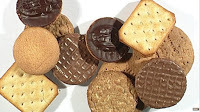 Not cookies.Cookie - Here in the UK this can only refer to a pale biscuit with chocolate chips in it. Any other ‘cookie’ is just a different kind of biscuit. What you call a biscuit, America, is in fact a scone - and a scone is absolutely not a biscuit. I'm glad we got that one clear.
Not cookies.Cookie - Here in the UK this can only refer to a pale biscuit with chocolate chips in it. Any other ‘cookie’ is just a different kind of biscuit. What you call a biscuit, America, is in fact a scone - and a scone is absolutely not a biscuit. I'm glad we got that one clear.
Color - We spell it colour. Just because you’re bigger than us doesn’t mean you can take away our Us. Ditto favorite/favourite. Stop being so annouying.
Herbs - Please pronounce the 'h'. As in heathens.
 Yellow lorry.
Yellow lorry.
 Red lorry.
Red lorry.
Truck - It’s a lorry. That ‘street car’ of yours is a tram. The big red one is a fire engine.
Elevator - It’s a lift. It’s easier for kids to say and they don’t get it confused with escalators (‘moving stairways’ to you).
A-LU-min-um - It’s a-lu-MINI-um, actually. We’ll forgive you on this one because even the guy who named it couldn't make up his mind.
Drugstore - Sounds practically illegal to us Brits. We call it the chemist’s or the pharmacy.
Freeway - Steady on, this sounds dangerously close to freewheeling. It’s the motorway, where one drives one’s motor, mater.
Rotary - You don’t have many of these bad boys over there. Over here, it’s a roundabout. Don’t ever visit Swindon.
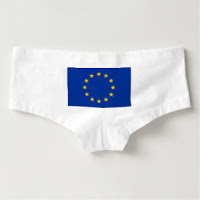 Pants.
Pants.
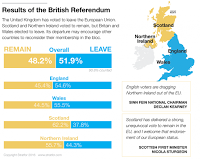 Really pants
Really pants
Pants - What is wrong with you people? They’re TROUSERS. Only Superman wears pants on the outside. Also, if something is 'pants', it's bad.
Underwear - PANTS. Or if you're a girl, you might call your pants knickers. Wallace and Gromit call them undercrackers and they should know. Underpants sounds a bit snooty.
Sweater - Why would you use this word when you could treat your mouth to ‘jumper’? Say it with me, America. ‘Jumper.’ Now go and Google Sultans of Ping.
Galoshes - You can’t wang a galosh. They’re WELLIES.
Robe - It’s a dressing gown. Only Her Majesty wears a robe.
Diaper - Nothing useful rhymes with this. For picture book purposes can we all just agree that nappy is so much easier to work with?
Bathing suit - What century is this? Come on, prissy pants, it’s a cozzie.
 Glue.
Glue.
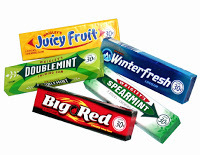 Gum.Gum - This is glue. Please don’t go confusing us over this, especially our kids. No one wants to chew on a pritt stick.
Gum.Gum - This is glue. Please don’t go confusing us over this, especially our kids. No one wants to chew on a pritt stick.
Math - Did you forget to + the 's’?
Vacation - This is a holiday, actually. Our holidays are for life, not just for Christmas.
Goof off - This sounds like a euphemism. Please can we muck about instead?
Recess - Sounds vaguely dental. Play time or break.
Parking lot - It’s a car park. (Where cars go to play, presumably.)
Cross walk - We call this a zebra crossing because we’re just so adorable. At least we used to be. *Brexit sigh*
 This lollipop man high fives the kids. Crossing guard - We have lollipop men and lollipop ladies. We like them, very much.
This lollipop man high fives the kids. Crossing guard - We have lollipop men and lollipop ladies. We like them, very much.
Gas - We use this to heat our homes and for cooking. We put petrol or fuel in our cars.
Sidewalk - Pavement is the word you’re looking for.
Dumpster - We call this a skip. I have no idea why. I concede: your word is better.
Apartment - Posh word for a flat.
Diner - We say ‘cafe’ to help us sound more European. I guess we'll be ditching 'cafe' soon.
French toast - It’s eggy bread, thank goodness, or we may not be allowed to make it post-Brexit.
French fries - These are CHIPS. Maybe we'll agree that the skinny ones are fries.
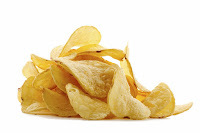 Crisps.
Crisps.
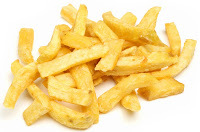 Chips.Potato chips - Crisps, because they’re crisp and it has fewer syllables.
Chips.Potato chips - Crisps, because they’re crisp and it has fewer syllables.
Jelly - Last time I checked this was actually called jam.
Jello - Hello? This is jelly.
Mom - MUM. Apart from in the Midlands.
Restroom - Stop being coy. It’s the loo, the lavvy, the toilet or the bog.
Faucet - Again, not great for pre-school rhyming. Let’s stick with tap.
Closet - We say wardrobe. Give it a try.
Trash can - Bin. Surely ours is a better word?
Mail - Post. As in, er… Royal Mail. I’ll have a word with them about that.
Soccer - Don’t even get us started on this one. Not now. It’s football. Your version of football is just plain silly.
Flashlight - Torch. Sticky plaster.
Sticky plaster.
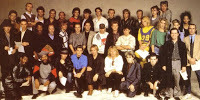 Band Aid.Band-aid - A charity supergroup headed up by Sting. We call those sticky bandage things plasters.
Band Aid.Band-aid - A charity supergroup headed up by Sting. We call those sticky bandage things plasters.
Fall - Autumn is so much more ...autumnal.
Eggplant - Aubergine.
Zucchini - Courgette.
Cilantro - Coriander. I’m glad I don’t write cook books.
Stand in line - This is queuing. We are the international champions.
Lady bug - Ladybird. Julia Donaldson wrote a whole book based on rhyming it with ‘heard’ and I bet no one asked her to rewrite that.
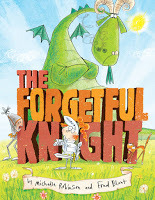 Any others I ought to have included? Do please add them in the comments below. If you're outside Britain, please also feel free to tell us you still love at least 48.1% of us and that somehow it's all going to be okay.
Any others I ought to have included? Do please add them in the comments below. If you're outside Britain, please also feel free to tell us you still love at least 48.1% of us and that somehow it's all going to be okay.
Meanwhile, my book ‘The Forgetful Knight’ publishes in the US on July 7th, illustrated by Fred Blunt who lives in Swindon and negotiates roundabouts on a daily basis. In America, they’re hailing our book as ‘Monty Python for kids’. That crazy British humoUr, eh?
Find out more about Michelle Robinson and her books, including advice on writing picture books here.
Happy July 4th, America. Independence is a sore point here in Britain right now. Amid all the gloom, I suppose there's still a place for the flippant, the fun and the frivolous. I hope this post brings a smile to your face, if only a teeny tiny one.

Some words just don't cross over the pond. For writers it's a pain in the bum (or the butt, depending on which side of the Atlantic you're sitting). Wherever you're writing, you may wish to go right ahead and avoid some of these nuisance words:-
Sneaker - What is this, America? Sounds like a stealthy fart to me. If we’re talking running shoes, it’s a trainer or even a dap.
Butt - My daughter has started using this word because she watches imported cartoons. It doesn't work in a British accent. We have bums and bottoms.
 Cookies.
Cookies.
 Not cookies.Cookie - Here in the UK this can only refer to a pale biscuit with chocolate chips in it. Any other ‘cookie’ is just a different kind of biscuit. What you call a biscuit, America, is in fact a scone - and a scone is absolutely not a biscuit. I'm glad we got that one clear.
Not cookies.Cookie - Here in the UK this can only refer to a pale biscuit with chocolate chips in it. Any other ‘cookie’ is just a different kind of biscuit. What you call a biscuit, America, is in fact a scone - and a scone is absolutely not a biscuit. I'm glad we got that one clear.Color - We spell it colour. Just because you’re bigger than us doesn’t mean you can take away our Us. Ditto favorite/favourite. Stop being so annouying.
Herbs - Please pronounce the 'h'. As in heathens.
 Yellow lorry.
Yellow lorry.
 Red lorry.
Red lorry.Truck - It’s a lorry. That ‘street car’ of yours is a tram. The big red one is a fire engine.
Elevator - It’s a lift. It’s easier for kids to say and they don’t get it confused with escalators (‘moving stairways’ to you).
A-LU-min-um - It’s a-lu-MINI-um, actually. We’ll forgive you on this one because even the guy who named it couldn't make up his mind.
Drugstore - Sounds practically illegal to us Brits. We call it the chemist’s or the pharmacy.
Freeway - Steady on, this sounds dangerously close to freewheeling. It’s the motorway, where one drives one’s motor, mater.
Rotary - You don’t have many of these bad boys over there. Over here, it’s a roundabout. Don’t ever visit Swindon.
 Pants.
Pants.
 Really pants
Really pantsPants - What is wrong with you people? They’re TROUSERS. Only Superman wears pants on the outside. Also, if something is 'pants', it's bad.
Underwear - PANTS. Or if you're a girl, you might call your pants knickers. Wallace and Gromit call them undercrackers and they should know. Underpants sounds a bit snooty.
Sweater - Why would you use this word when you could treat your mouth to ‘jumper’? Say it with me, America. ‘Jumper.’ Now go and Google Sultans of Ping.
Galoshes - You can’t wang a galosh. They’re WELLIES.
Robe - It’s a dressing gown. Only Her Majesty wears a robe.
Diaper - Nothing useful rhymes with this. For picture book purposes can we all just agree that nappy is so much easier to work with?
Bathing suit - What century is this? Come on, prissy pants, it’s a cozzie.
 Glue.
Glue. Gum.Gum - This is glue. Please don’t go confusing us over this, especially our kids. No one wants to chew on a pritt stick.
Gum.Gum - This is glue. Please don’t go confusing us over this, especially our kids. No one wants to chew on a pritt stick.Math - Did you forget to + the 's’?
Vacation - This is a holiday, actually. Our holidays are for life, not just for Christmas.
Goof off - This sounds like a euphemism. Please can we muck about instead?
Recess - Sounds vaguely dental. Play time or break.
Parking lot - It’s a car park. (Where cars go to play, presumably.)
Cross walk - We call this a zebra crossing because we’re just so adorable. At least we used to be. *Brexit sigh*
 This lollipop man high fives the kids. Crossing guard - We have lollipop men and lollipop ladies. We like them, very much.
This lollipop man high fives the kids. Crossing guard - We have lollipop men and lollipop ladies. We like them, very much.Gas - We use this to heat our homes and for cooking. We put petrol or fuel in our cars.
Sidewalk - Pavement is the word you’re looking for.
Dumpster - We call this a skip. I have no idea why. I concede: your word is better.
Apartment - Posh word for a flat.
Diner - We say ‘cafe’ to help us sound more European. I guess we'll be ditching 'cafe' soon.
French toast - It’s eggy bread, thank goodness, or we may not be allowed to make it post-Brexit.
French fries - These are CHIPS. Maybe we'll agree that the skinny ones are fries.
 Crisps.
Crisps.
 Chips.Potato chips - Crisps, because they’re crisp and it has fewer syllables.
Chips.Potato chips - Crisps, because they’re crisp and it has fewer syllables.Jelly - Last time I checked this was actually called jam.
Jello - Hello? This is jelly.
Mom - MUM. Apart from in the Midlands.
Restroom - Stop being coy. It’s the loo, the lavvy, the toilet or the bog.
Faucet - Again, not great for pre-school rhyming. Let’s stick with tap.
Closet - We say wardrobe. Give it a try.
Trash can - Bin. Surely ours is a better word?
Mail - Post. As in, er… Royal Mail. I’ll have a word with them about that.
Soccer - Don’t even get us started on this one. Not now. It’s football. Your version of football is just plain silly.
Flashlight - Torch.
 Sticky plaster.
Sticky plaster. Band Aid.Band-aid - A charity supergroup headed up by Sting. We call those sticky bandage things plasters.
Band Aid.Band-aid - A charity supergroup headed up by Sting. We call those sticky bandage things plasters.Fall - Autumn is so much more ...autumnal.
Eggplant - Aubergine.
Zucchini - Courgette.
Cilantro - Coriander. I’m glad I don’t write cook books.
Stand in line - This is queuing. We are the international champions.
Lady bug - Ladybird. Julia Donaldson wrote a whole book based on rhyming it with ‘heard’ and I bet no one asked her to rewrite that.
 Any others I ought to have included? Do please add them in the comments below. If you're outside Britain, please also feel free to tell us you still love at least 48.1% of us and that somehow it's all going to be okay.
Any others I ought to have included? Do please add them in the comments below. If you're outside Britain, please also feel free to tell us you still love at least 48.1% of us and that somehow it's all going to be okay. Meanwhile, my book ‘The Forgetful Knight’ publishes in the US on July 7th, illustrated by Fred Blunt who lives in Swindon and negotiates roundabouts on a daily basis. In America, they’re hailing our book as ‘Monty Python for kids’. That crazy British humoUr, eh?
Find out more about Michelle Robinson and her books, including advice on writing picture books here.
Published on July 04, 2016 00:00



